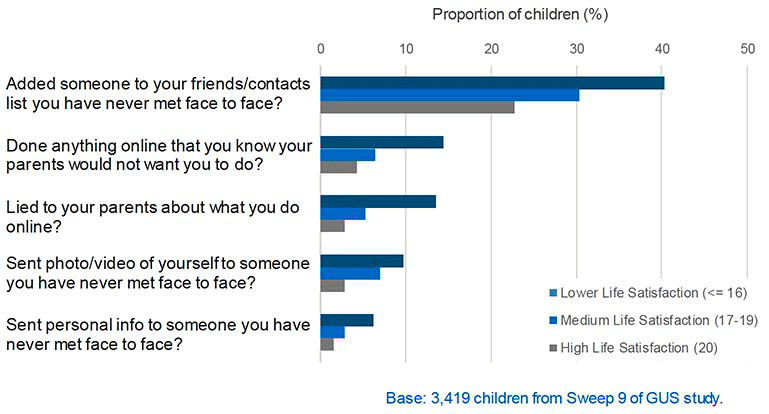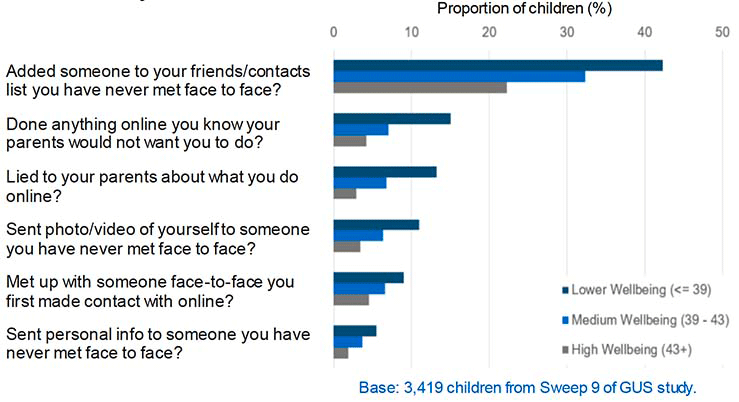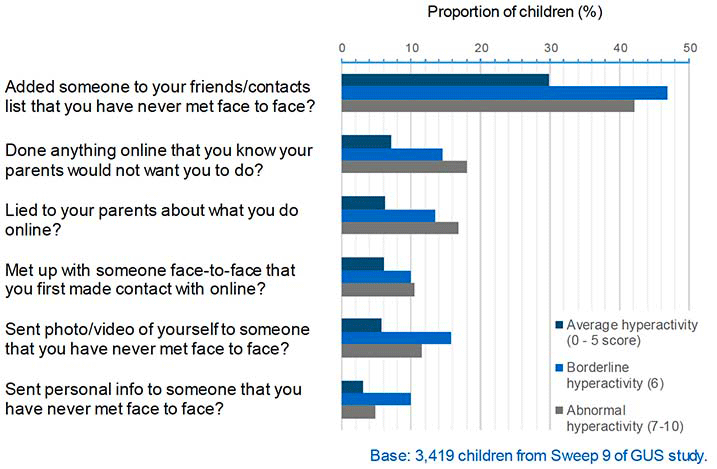Engaging in risky online behaviour - prevalence and associated factors: initial findings
Initial findings on prevalence and associated factors at age 12 from the Growing Up in Scotland Survey on engaging in risky online behaviour.
4. Individual Factors
4.1 Gender
A larger proportion of boys than girls had engaged in each of the risky online behaviours – see Appendix 10.2 - Table 2.
Boys were more likely than girls to have engaged in the following behaviours:
- 26% of girls / 40% of boys had added someone to their friends/contacts list who they had never met face to face.
- 6% of girls / 10% of boys had done something online that they knew their parents would not want them to do.
- 6% of girls / 10% of boys have lied to their parents about what they did online.
- 6% of girls / 8% of boys have met up with someone face to face who they first made contact with online.
However, all of these associations were weak, and there were no other statistically significant associations found across the other two behaviours (e.g. sending personal information, or sending a photo/ video of themselves to someone they had never met face-to-face).
4.2 Household qualification
The highest education level in the household was used here as an indicator of the socio-economic background of the child.
Children from households with no qualifications were more likely to have met up with someone face-to-face with who they first made contact online than those from households with qualifications.
Fifteen per cent of children from households with no qualification reported meeting up with someone face-to-face with who they first made contact online, compared to 6% from households with degree level qualifications, or 3% from households with lower level qualifications[5].
Children from households with degree qualifications were less likely to have sent personal information to someone with who they never met face-to-face than those from other households.
Two per cent of children from households with degree level academic/ vocational qualifications had sent personal information to someone that they had never met face-to-face. Those from households with intermediate level qualifications[6] were more likely than others to have engaged in this behaviour (10% of children from intermediate qualification level households, compared to 7% of children from lower qualification level households).
However, both of these associations were very weak. Indeed, for most of the behaviours, there was no association between household educational level and participating in risky online behaviour – see Appendix 10.2 - Table 3. No significant association was found between any of the behaviours and SIMD.
4.3 Life Satisfaction
Life satisfaction was measured using selected items from the Students' Life Satisfaction Scale (Huebner, 1991). Children were asked:
- Do you feel that your life is going well?
- Do you wish your life was different?
- Do you feel that your life is just right?
- Do you feel you have what you want in life?
- Do you feel you have a good life?
Possible responses were: never, sometimes, often, or always. Responses to each of these questions were added together to represent children's overall life satisfaction. The scale has a minimum score of 5 and a maximum of 20 with a higher number indicating higher life satisfaction. For analysis, life satisfaction scores were grouped into three equally sized categories – see Appendix 10.1 for further methodological detail.
Children who reported lower life satisfaction (a score of less than or equal to 16) were more likely to have participated in five of the risky online behaviours, see Figure 4. A small association was found between a child's life satisfaction score and lying to their parents about what they had done online. A total of 14% of children with lower life satisfaction had engaged in this behaviour compared to 3% of children with higher life satisfaction. Though it is unclear from this analysis what the direction of this relationship is (e.g. if lower life satisfaction leads children to engage in this behaviour, or if engaging in this behaviour leads to a lower life satisfaction).
A higher proportion of children with lower life satisfaction had also:
- added someone to their friends/contacts list they had never met face-to-face (40% of those with low life satisfaction)
- done anything online their parents would not want them to do (14%)
- sent a photo/video of themselves to someone they had never met face-to-face (10%)
- sent personal information to someone they had never met face-to-face (6%).
However, it should be noted that the association for the final two behaviours was less strong, see Appendix 10.2 - Table 4 for further details.

4.4 Mental Wellbeing
Mental wellbeing was measured using the Kidscreen Health-Related Quality of Life scale (Ravens-Sieberer et al., 2005; the Kidscreen Group, 2006). Children were asked the following ten questions about their wellbeing:
- Have you felt fit and well?
- Have you felt full of energy?
- Have you felt sad?
- Have you felt lonely?
- Have you had enough time for yourself?
- Have you been able to do the things that you want to do in your free time?
- Have your parent(s) treated you fairly?
- Have you had fun with your friends?
- Have you got on well at school?
- Have you been able to pay attention?
Each question had five possible responses: not at all, slightly, moderately, very, extremely. Responses to each of these questions were added together to represent children's overall wellbeing. The scale has a minimum score of 10 and a maximum of 50 with a higher number indicating higher wellbeing. Wellbeing scores were grouped into three equally sized categories – see Appendix 10.2 – Table 4.

On average, children scored 40.5 on the scale, indicating a high level of wellbeing. Children who reported lower wellbeing were more likely to have engaged in all six risky online behaviours than those with higher wellbeing, see Figure 6

In particular, children with low wellbeing scores were more likely to have:
- added someone to their friends/contacts list they had never met face-to-face (42% of children with low wellbeing compared to 22% of those with high wellbeing scores).
- done something online their parents would not want them to do (15%, compared to 4% of those with high wellbeing).
- lied to their parents about what they do online (13%, compared to 3% of children with high wellbeing scores).
Although still statistically significant, differences were less pronounced when examining children who had sent a photo/video of themselves to someone that they had never met face-to-face (10% of those with low wellbeing scores, compared to 3% of those with high wellbeing scores).
Only very weak associations were found between wellbeing and children that had sent personal information to someone they had never met face-to-face, or those that had met up with someone face-to-face with who they had first made contact online – see Appendix 10.2 - Table 4. As with life satisfaction, it is unclear from this analysis what the direction of these relationship is (e.g. if lower wellbeing leads children to engage in this behaviour, or if engaging in this behaviour leads to a lower wellbeing).
4.5 Hyperactivity/ inattention
Social, emotional and behavioural development is measured by questions taken from the Strengths and Difficulties Questionnaire (Goodman, 1997). Children were asked to respond to the following statements:
- I am restless, I cannot stay still for long
- I am constantly fidgeting or squirming
- I am easily distracted, I find it difficult to concentrate
- I think before I do things
- I finish the work I am doing.
- My attention is good
Each statement had three possible responses: not true, somewhat true, certainly true. Responses to each of these questions were added together to give a measure on the hyperactivity scale. Scores could range from 0-10, with 0-5 representing average hyperactivity, 6 being borderline hyperactivity, and 7-10 classed as abnormal hyperactivity[7].
Those with borderline or abnormal levels of hyperactivity/ inattention were more likely to have engaged in all six risky online behaviours, compared to those with normal levels of hyperactivity/ inattention.
As shown in Figure 7, differences in the proportion of those with abnormal or borderline hyperactivity/ inattention engaging in risky online behaviours were small. Those with abnormal hyperactivity/ inattention were not always more likely to have engaged in the risky online behaviours than those with borderline hyperactivity. For example, just under half of children (47%) with borderline hyperactivity had added someone to their friends/ contact list they had never met face-to-face, compared to 42% of those with abnormal hyperactivity and 30% of those with average hyperactivity. In only two of the risky online behaviours (doing something online their parents would not want them to do, and lying to their parents about what they do online) did a higher proportion of those with abnormal hyperactivity engage in the behaviour.
This analysis cannot determine the direction of these associations, most of which were weak. Very weak associations were found for those meeting up with someone with who they had first made contact online, and sending personal information. See Appendix 10.2 - Table 5 for further detail.

4.6 Emotional Symptoms
Social, emotional and behavioural development is measured by questions taken from the Strengths and Difficulties Questionnaire (Goodman, 1997). The child's main caregiver was asked to respond to the following statements about their child:
- Often complains of headaches, stomach-aches or sickness
- Has many worries, often seems worried
- Often unhappy, downhearted or tearful
- Nervous or clingy in new situations, easily loses confidence
- Has many fears, is easily scared
Each statement had four possible responses: not true, somewhat true, certainly true, can't say. Responses to each of these questions were added together to give a measure on the emotional symptoms scale.
Scores ranged from 0-10, with scores from 0-3 considered normal, 4 as borderline, and 5-10 as abnormal.
Children who were identified as having abnormal emotional symptoms were more likely to have done something online they know their parents would not want them to do.
Just over one in ten (14%) children with abnormal emotional symptoms had done this, compared to 8% of those identified as having borderline symptoms, and 8% of those with average emotional symptoms.
This association however was very weak – see Appendix 10.2 - Table 5 - and does not tell us about the direction of the relationship. No association was seen for any of the other five risky online behaviours.
Contact
Email: GUS@gov.scot
There is a problem
Thanks for your feedback